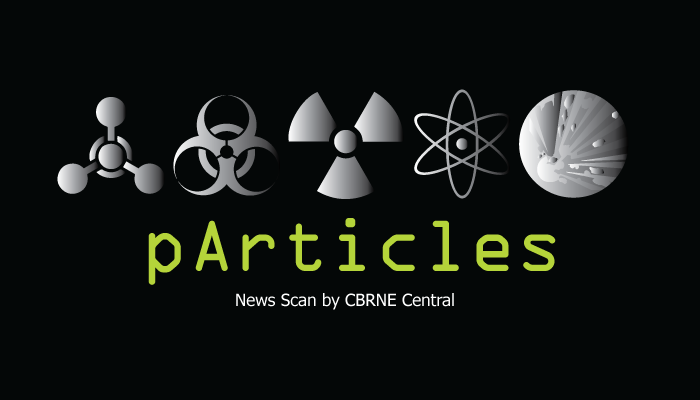Topics in this issue of CBRNE Particles include bio-agent field detection, stabilizing Hanford’s radioactive waste, and shortages of trained bomb-sniffing canines.
In This Article
COUNTERTERRORISM
Why the Government Can’t Bring Terrorism Charges in Charlottesville
When Attorney General Jeff Sessions was asked how he viewed the car attack in Charlottesville, Va., here’s how he responded: “It does meet the definition of domestic terrorism in our statute,” he told ABC’s Good Morning America. That certainly seems to suggest the government is looking into a possible terrorism charge against the suspect, 20-year-old James Alex Fields Jr. At Saturday’s rally organized by white supremacists, a car slammed into counterprotesters, killing one and injuring 19. But according to the Justice Department and legal analysts, it’s simply not possible for the government to file charges of domestic terrorism, because no such criminal law exists. NPR >>
Trump’s Charlottesville Response Stirs Debate on ‘Domestic Terrorism’
Civil rights advocates for years have argued that the U.S. has a double standard when it comes to political violence, with only acts committed by Muslims labeled “terrorism.” The term is rarely applied, they say, to attacks by right-wing white extremists like Dylann Roof, who was charged with hate crimes after opening fire in a black church in South Carolina in 2015. The Hill >>
America Is Running Out of Bomb-Sniffing Dogs
With terrorists increasingly attacking so-called soft targets, the demand for detection dogs that can sweep large areas for explosives has soared. So have prices, which can exceed $25,000 for a single dog. Security experts warn that the supply of these dogs is dwindling worldwide and that the United States is especially vulnerable because it relies primarily on brokers who source dogs from Eastern Europe. NY Times >>
Training Bomb-Sniffing Dogs Could Improve with New Mass Spectrometry Tool
Handlers typically present bomb-sniffing dogs with training materials containing 2,4,6-trinitrotoluene (TNT), triacetone triperoxide (TATP), and other explosives to teach them to recognize the vapor plumes the materials emit. The handlers then hide the materials and evaluate the dogs’ ability to find them. Problem is, handlers often use multiple training materials during a session, which can lead to cross-contamination of one material with another. Without a way to measure the molecular composition of the vapors coming off the materials, such contamination can go undetected, muddling the results of dogs’ performance evaluations. C&EN >>
Boko Haram Favors Women, Children as Suicide Bombers, Study Reveals
The majority of suicide bombers used by terror group Boko Haram to kill innocent victims are women and children, a US study reveals. Researchers at the Combating Terrorism Center at West Point and Yale University analyzed the 434 suicide bombings carried out by Nigeria-based militants Boko Haram since 2011, and found that at least 244 of the 338 attacks in which the bomber’s gender could be identified were carried out by women. CNN >>
Suicide Bombers Kill 27, Wound 83 in Northeast Nigeria
A woman suicide bomber blew herself up and killed 27 others at a market in northeast Nigeria on Tuesday, two local officials said, in an attack bearing the hallmark of Boko Haram militants. Two more suicide bombers detonated their devices at the gates to a nearby refugee camp, wounding many people, an emergency services official said. Reuters >>
ISIS Claims Suicide Bombing That Killed at Least 15 in Pakistan
A suicide bomber riding a motorcycle rammed into a military truck near a busy bus station in southwestern Pakistan, killing at least 15 people, including eight soldiers, and wounding at least 40 others, military officials said on Sunday. NY Times >>
FORENSICS
George Mason’s New Center of Excellence for Criminal Investigations and Network Analysis
DHS S&T has selected George Mason University in Fairfax, Virginia to lead a consortium of U.S. academic institutions and other partners for a new Center of Excellence in Criminal Investigations and Network Analysis (CINA). The Center’s research will focus on criminal network analysis, dynamic patterns of criminal activity, forensics, and criminal investigative processes. Homeland Security News Wire >>
Nuclear Forensics as Nuclear Material Analysis for Security Purposes
An argument can be made that nuclear forensics would benefit from taking stock of its roots and considering an expansion of its scope or improved awareness of and collaboration with other frameworks, such as verification of non-proliferation and disarmament treaties. The consolidation of various dimensions of nuclear forensics— or of nuclear material analysis for security purposes— would cut costs and provide new and possibly unexpected synergies between different applications. SIPRI >>
RADIOLOGICAL + NUCLEAR
How ISIS Nearly Stumbled on the Ingredients for a ‘Dirty Bomb’
On the day the Islamic State overran the Iraqi city of Mosul in 2014, it laid claim to one of the greatest weapons bonanzas ever to fall to a terrorist group. But what they missed was locked away in a storage room on a Mosul college campus were two caches of cobalt-60, a metallic substance with lethally high levels of radiation. When contained within the heavy shielding of a radiotherapy machine, cobalt-60 is used to kill cancer cells. In terrorists’ hands, it is the core ingredient of a “dirty bomb,” a weapon that could be used to spread radiation and panic. Washington Post >>
No Easy Answers for Stabilizing Hanford Radioactive Waste Tunnel
The Department of Energy has come up with a range of options to protect the public and environment from the threat of collapse of another Hanford waste tunnel. But none of them is perfect. DOE discussed the options with about 50 people attending a public meeting and more listening on the internet in Richland. Tri-City Herald >>
Cobalt 60 Sources in Mosul: Recovery and Lessons for the Future
Two years ago, in the summer of 2015, the Institute decided to investigate whether Daesh controlled dangerous radioactive material in Iraq or Syria. The result of a few months of study by Sarah Burkhard, a young scientist, and other staff surprised us all. Their investigations found that there were apparently two sources of radioactive cobalt in Mosul that posed a risk of being used in a radiological dispersal device. Institute for Science and International Security >>
Nuclear Lab Shipments Pose Risks to Public
A new report suggests that improperly shipped materials from the nation’s nuclear weapons facilities could pose risks to unwitting workers and the public. While the materials were not ultimately lost, the documents reveal repeated instances in which hazardous substances vital to making nuclear bombs and their components were mislabeled before shipment. That means those transporting and receiving them were not warned of the safety risks and did not take required precautions to protect themselves or the public. Chem.info >>
NK Has 13-30 Nuclear Weapons, and Will Have Up to 60 Nukes By 2020
North Korea is estimated to have 33 kilograms of separated plutonium, and between 175 and 645 kilograms of weapon-grade uranium. If NK used 70 percent of the available estimated stocks of plutonium and weapon-grade uranium to make nuclear bombs, then, depending on the yield of each bomb, its nuclear arsenal would now consist of between 13 and 30 nuclear weapons. Homeland Security News Wire >>
Yucca Mountain. Again.
Another “Groundhog Day” has dawned for Yucca Mountain, which is once again being proposed as a geologic repository for the United States’ highly radioactive waste. President Trump’s budget request includes $120 million to restart the licensing process, and the House is considering legislation to mandate a Yucca Mountain reboot. Bulletin of the Atomic Scientists >>
Plutonium Oxide Shipments to SRS On Hold
Suspension of plutonium oxide shipments to the Savannah River Site could impede startup operations at the Mixed Oxide, or MOX, fuel fabrication facility, according to a nuclear watchdog group. Savannah River Site Watch, which opposes MOX, cites a pair of government reports that discuss the shipments. Aiken Standard >>
BIOLOGICAL DEFENSE + HEALTH SECURITY
Interview with Edward You, FBI Weapons Of Mass Destruction Directorate, Biological Countermeasures Unit
Edward You is a Supervisory Special Agent in the FBI’s Weapons of Mass Destruction Directorate, Biological Countermeasures Unit. Mr. You is responsible for creating programs and activities to coordinate and improve FBI and interagency efforts to identify, assess, and respond to biological threats or incidents. These efforts include expanding FBI outreach to the life sciences community to address biosecurity. Before being promoted to the Weapons of Mass Destruction Directorate, Mr. You was a member of the FBI Los Angeles Field Office Joint Terrorism Task Force and served on the FBI Hazardous Evidence Response Team. Combating Terrorism Center at West Point >>
What It Means to Militarize Biotechnology
Biotechnology is a fickle beast and a frequently debated topic. While many focus on the security implications of gene-editing and other biotechnologies in the hands of nefarious actors, there has been an increasing militarization of the field. Pandora Report >>
It’s Getting Too Easy to Create Dangerous Viruses
The news that researchers have recreated an extinct cousin to the smallpox virus using only commercially available technology and items purchased over the Internet renews concerns that bioterrorists could do the same if detailed information about the methods were published. Here’s the problem: scientific journals are geared toward publication, often without sufficient understanding of the public-security risks. Defense One >>
Bio-Agent Field Detection. The Invisible, Elusive Enemy
The dilemma is the passing of time in regard to a BWA attack and the latent onset of illness. Unfortunately, once a BWA is dispersed and a few days pass and victims begin to present illness, the mortality rate increases exponentially! For this reason, early, substantial and accurate field detection performed by trained and competent responders is paramount in the fight against biological terrorism. If the appropriate prophylaxis is not administered in a timely manner after an attack, lives will most certainly be in jeopardy. CBRNe Portal >>
CHEMICAL WEAPONS + SAFETY
Long Ignored: The Use of Chemical and Biological Weapons Against Insurgents
Throughout history, chemical and biological agents have demonstrated effectiveness against ill-equipped, ill-prepared, or poorly trained adversaries, especially insurgents. Examples of the use of these weapons against insurgents include Spain (Rif war, 1921-1927), Italy (1935-1936), Egypt (1963-1967), Rhodesia (mid-late 1970s), South Africa (1980s), Libya (1987), Iraq (1988), and Syria (2013-ongoing). And while the Spanish, Italian, Egyptian and Libyan uses are examples of the use of chemical weapons in inter-state conflict, most of the cases involve colonial governments using the weapons against native insurrections. War on the Rocks >>
Nerve Agents Detected When Fluoridation Selected
Initial detection of chemical agents in the field is often carried out by ion mobility spectrometry, with confirmation by portable GC-MS. However, less volatile nerve agents, such as VX and related compounds, are not easy to detect by the latter method. INFICON’s Hapsite ER instrument is able to detect a wide range of volatile nerve agents and other chemical weapons by GC-MS, but cannot detect VX, which is strongly retained on the sampling probe, column and hydrophobic membrane. Separations Now >>
Increased Concern for Chemical Weapons Attacks
The use of chemical agents for injuring and killing people is increasing in conflict areas such as Syria and Iraq. This is apparent from FOI’s latest report to the Armed Forces, on the CBRN threat from non-state actors. “We can see that in conflict areas such as Syria and Iraq there are actors that demonstrate an ambition to increase their capacity to use CBRN. Earlier, they would deploy them by exploding tanks of hazardous materials, but now we can observe that they have begun to produce and are trying to develop these materials themselves,” says Magnus Normark, senior analyst in FOI’s CBRN Defence and Security Division. FOI Sweden >>
Mission Impossible? Investigating the Khan Sheikhoun Nerve Gas Attack in Syria
The Joint Investigative Mechanism (JIM) inspectors have more freedom to shape their mission and pursue leads than the Fact-Finding Mission, which was constrained by its narrow yes-or-no mandate. If its liaison visa is ever approved, it is also possible that the JIM will be able to conduct in-country inspections in ways that the Fact-Finding Mission was never able to do. But realistically speaking, the most important element of an investigation—a visit to the crime scene in Khan Sheikhoun—may simply be too dangerous to try, not least because the only thing we know with certainty is that at least one party to the conflict has an interest in turning such an expedition into a violent tragedy. Century Foundation >>
Report of the Scientific Advisory Board’s Workshop on Emerging Technologies
The OPCW Scientific Advisory Board held an Innovative Technologies for Chemical Security workshop last month in Brazil, the third of a series intended to inform the report of the SAB on developments in science and technology to the Fourth Review Conference of the Chemical Weapons Convention to be held in December 2018. The workshop explored the potential of new technologies to enhance capabilities necessary for implementation of the Convention. Organisation for the Prohibition of Chemical Weapons >>
Environmental Chemical Risk Assessment: Traditional vs Public Health Perspectives
For the past several decades, human health risk assessment has been a pillar of environmental health protection. In general, the products of risk assessment have been numerical risk values derived from animal toxicology studies of observable effects at high doses of individual chemicals. Although this approach has contributed to our understanding of overt health outcomes from chemical exposures, it does not always match our understanding from epidemiology studies of the consequences of real-world exposures in human populations, which are characterized by exposure to multiple pollutants, often chronically, at concentrations that can fluctuate over wide ranges; susceptible populations and life stages; potential interactions between chemicals and nonchemical stressors and background disease states; and lifestyle factors that modify exposures. American Journal of Public Health >>
A Combined Theoretical and Experimental Study of Sarin (GB) Decomposition at High Temperatures
Theoretical and experimental results are presented for the pyrolytic decomposition of the nerve agent sarin (GB) in the gas phase. High-level quantum chemistry calculations are performed together with a semiclassical transition-state theory for describing quantum mechanical tunneling. The experimental and theoretical results for the temperature dependence of the survival times show very good agreement, as does the calculated and measured activation energy for thermal decomposition. Journal of Physical Chemistry >>
SPECIAL INTEREST
Will Nagasaki’s Story Be Told at Washington State’s New National Park?
A document released this year outlines basic themes for Manhattan Project National Historical Park, which in Hanford offers tours of a shuttered reactor and other sites. But it’s expected to take years to develop exhibits with artifacts and oral histories. Funds are tight, with sites in three states this year sharing a $680,000 budget. Seattle Times >>
In the Event of a Nuclear Blast, Don’t Condition Your Hair
If, for some reason, you find yourself in a situation where you need to wash radioactive material from your body, don’t reach for the bottle of hair conditioner. Conditioner can bind radioactive particles to your hair. That warning was part of guidelines issued last Friday by Guam’s Office of Civil Defense, following threats from North Korea that it was preparing to test a missile that would create an “enveloping fire” around the U.S. territory. NPR >>


